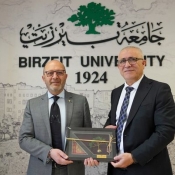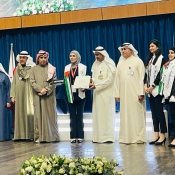French Astronomer Lectures on Galaxy Structure
Insights into fundamental physics and its astrophysical role in the formation and evolution of our galaxies was discussed by visiting professor Dominique Ballereau, an astronomer at the Paris-Meudon Observatory in France, in a two-day astronomy colloquium held on April 11 and 13, 2016.The lectures, organized by the Department of Physics, were entitled “What is there at the center of our Galaxy?” and “The Exploanets,” about extrasolar planets that orbit a star other than the sun.“Our Galaxy, the Milky Way, is a gigantic spiral disk containing our solar system in addition to billions of other stars, planets, moons, asteroids, comets, neutron stars and black holes. Astronomers believe that the center of our galaxy is a home for a supermassive black hole whose mass is estimated to be more than four million times the mass of the sun,” Ballereau said.“In addition to our solar system,” Ballerau added, “there are extrasolar systems in our galaxy where planets orbit stars other than the sun. These planets are called ‘exoplanets’ or extrasolar planets. The discovery of these systems is relatively new in astronomy. A few thousand exoplanets have been discovered in the past two decades, mostly with NASA's Kepler space telescope.”He alluded that one of the interesting extrasolar systems that has been discovered is called “Kepler-51” system, which has three planets orbiting a star that has properties very similar to the properties of the sun.The colloquium were held in the university’s Michel and Sanieh Hakim Observatory and attracted a large number of faculty members and students interested in astronomy from Birzeit and other local universities.







